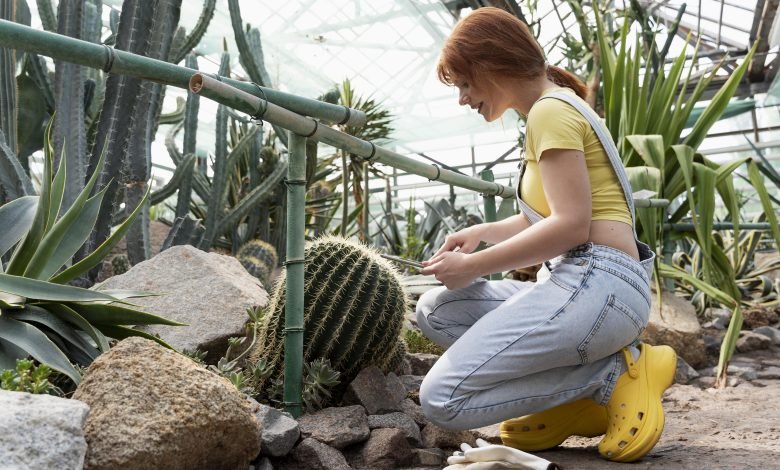The Art of Trimming Cactus: Tips and Techniques

Introduction:
Cactus is a type of succulent plant that can be found in many different shapes and sizes. While these plants are known for their hardiness and low-maintenance requirements, trimming cactus is still a necessary task that can help keep the plant healthy and beautiful.
Whether you’re a seasoned gardener or just starting out, learning how to trim your cactus can be a valuable skill. In this article, we’ll cover everything you need to know about trimming cactus in Arizona, including when to do it, how to do it safely, and what tools you’ll need.
When to Trim Your Cactus:
Cactus trimming should only be done during the plant’s active growing season, which typically falls between spring and summer. This is when the plant is actively producing new growth and can handle the stress of trimming.
It’s important to avoid trimming your cactus during the dormant season, which is usually during the fall and winter months. During this time, the plant is storing up energy for the next growing season and may not have the resources to heal itself from any damage caused by trimming.
Tools you’ll need:
Before you start trimming your cactus, it’s important to have the right tools on hand. Here are some of the tools you’ll need:
- Pruning shears: These are used to make clean cuts on smaller cacti.
- Long-handled loppers: These are used to make cuts on larger cacti.
- Gloves: These are essential for protecting your hands from the spines of the cactus.
- Eye protection: This is also important for protecting your eyes from any flying spines.
How to Trim Your Cactus:
Now that you have the right tools, it’s time to get started. Here’s a step-by-step guide on how to trim your cactus:
- Put on your gloves and eye protection.
- Use your pruning shears or loppers to make a clean cut just above a healthy, new growth point.
- If you’re trimming a larger cactus, use your long-handled loppers to make the cut.
- If the cactus has any dead or damaged parts, use your pruning shears or loppers to remove them.
- If you’re trimming a cactus with multiple branches, be sure to trim each branch individually.
- After you’ve finished trimming your cactus, give it a good watering to help it heal.
Tips and Techniques for Trimming Your Cactus:
Trimming a cactus is a task that requires a lot of care and attention. While it might seem like a straightforward process, there are several things to keep in mind to ensure that your cactus stays healthy and thriving. Here are some tips and techniques for trimming your cactus:
Work slowly and carefully:
One of the most important things to remember when trimming your cactus is to work slowly and carefully. These plants have sharp spines that can cause injury, so it’s essential to wear protective gear and take your time. Be sure to make clean cuts to avoid damaging the plant, and always cut above a healthy, new growth point.
Know when to stop:
It’s important to remember that trimming your cactus is not a task that you should do excessively. Over-trimming your cactus can cause it to become weak and stunted. Only trim what is necessary and avoid cutting too much off at once. It’s also a good idea to wait until the cactus has fully healed before trimming it again.
Watch for signs of disease or pests:
While you’re trimming your cactus, it’s a good idea to keep an eye out for any signs of disease or pests. These can include discoloration, wilting, or unusual growth patterns. If you notice any issues, take action immediately to prevent them from spreading to the rest of the plant. You may need to use pesticides or other treatments to get rid of pests or disease.
Don’t forget to fertilize:
After you’ve finished trimming your cactus, it’s essential to fertilize it to promote healthy growth. Use a balanced, slow-release fertilizer and follow the manufacturer’s instructions. Fertilizing your cactus can help it recover from any stress caused by trimming and encourage new growth.
Water your cactus appropriately:
After you’ve trimmed your cactus, it’s also important to water it appropriately. Be sure to give it a deep watering, but don’t overwater it, as this can lead to root rot. Allow the soil to dry out between watering, and avoid getting water on the cactus’s spines.
Use appropriate pruning tools:
Using the right pruning tools is essential for trimming your cactus safely and effectively. Pruning shears and loppers are the most common tools used for trimming cacti. Choose tools with sharp blades that can make clean cuts, and make sure they are properly sterilized before use. This can help prevent the spread of disease or pests from one plant to another.
Know the type of cactus you have:
Different types of cacti require different trimming techniques, so it’s important to know the specific needs of your plant. Some cacti, for example, should only be pruned at certain times of the year, while others may require more or less frequent trimming. Research the specific needs of your cactus to ensure that you’re providing it with the best care possible.
In conclusion
Trimming your cactus is a necessary task that can help keep your plant healthy and beautiful. By following these tips and techniques, you can ensure that your cactus stays in top condition and thrives for years to come. Remember to work slowly and carefully, know when to stop, watch for signs of disease or pests, fertilize appropriately, use the right pruning tools, and know the specific needs of your cactus.




